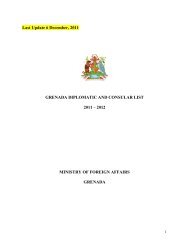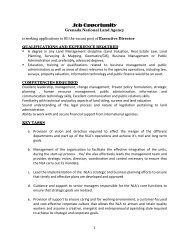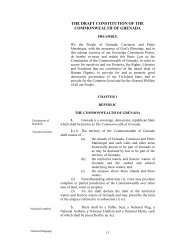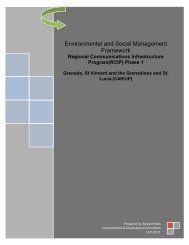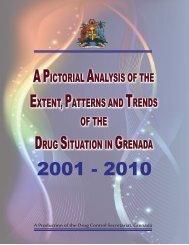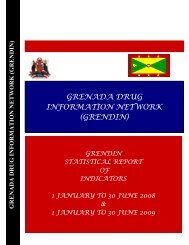Doing Business 2009 - Government of Grenada
Doing Business 2009 - Government of Grenada
Doing Business 2009 - Government of Grenada
You also want an ePaper? Increase the reach of your titles
YUMPU automatically turns print PDFs into web optimized ePapers that Google loves.
Firms consistently rate access to credit as among the greatest barriers to their operation and growth. <strong>Doing</strong> <strong>Business</strong><br />
constructs two sets <strong>of</strong> indicators <strong>of</strong> how well credit markets function: one on credit registries and the other on legal<br />
rights <strong>of</strong> borrowers and lenders. Credit registries, institutions that collect and distribute credit information on<br />
borrowers, can greatly expand access to credit. By sharing credit information, they help lenders assess risk and<br />
allocate credit more efficiently. And they free entrepreneurs from having to rely on personal connections alone when<br />
trying to obtain credit. Three indicators are constructed to measure the sharing <strong>of</strong> credit information:<br />
• Depth <strong>of</strong> credit information index, which measures the extent to which the rules <strong>of</strong> a credit information system<br />
facilitate lending based on the scope <strong>of</strong> information distributed, the ease <strong>of</strong> access to information and the quality <strong>of</strong><br />
information.<br />
• Public registry coverage, which reports the number <strong>of</strong> individuals and firms covered by a public credit registry as a<br />
percentage <strong>of</strong> the adult population.<br />
• Private bureau coverage, which reports the number <strong>of</strong> individuals and firms, covered by a private credit bureau as a<br />
percentage <strong>of</strong> the adult population.<br />
The strength <strong>of</strong> legal rights index measures the degree to which collateral and bankruptcy laws protect the rights <strong>of</strong><br />
borrowers and lenders and thus facilitate lending. This year, three main changes were made; first, a standardized case<br />
scenario with specific assumptions was introduced to bring this indicator into line with other <strong>Doing</strong> <strong>Business</strong><br />
indicators. Second, the indicator now focuses not on tangible movable collateral, such as equipment, but on<br />
revolving movable collateral, such as accounts receivable and inventory. Third, the indicator no longer considers<br />
whether management remains in place during a reorganization procedure, better accommodating economies that<br />
adopt reorganization procedures. The strength <strong>of</strong> legal rights index includes 8 aspects related to legal rights in<br />
collateral law and 2 aspects in bankruptcy law:<br />
• Any business may use movable assets as collateral while keeping possession <strong>of</strong> the assets, and any financial<br />
institution may accept such assets as collateral.<br />
• The law allows a business to grant a non possessory security right in a single category <strong>of</strong> revolving movable assets,<br />
without requiring a specific description <strong>of</strong> the secured assets.<br />
• The law allows a business to grant a non possessory security right in substantially all <strong>of</strong> its assets, without requiring<br />
a specific description <strong>of</strong> the secured assets.<br />
• A security right may extend to future or after-acquired assets and may extend automatically to the products,<br />
proceeds or replacements <strong>of</strong> the original assets.<br />
• General description <strong>of</strong> debts and obligations is permitted in collateral agreements and in registration documents, so<br />
that all types <strong>of</strong> obligations and debts can be secured by stating a maximum rather than a specific amount between<br />
the parties.<br />
• A collateral registry is in operation that is unified geographically and by asset type and that is indexed by the name<br />
<strong>of</strong> the grantor <strong>of</strong> a security right.<br />
• Secured creditors are paid first when a debtor defaults outside an insolvency procedure or when a business is<br />
liquidated.<br />
• Secured creditors are not subject to an automatic stay or moratorium on enforcement procedures when a debtor<br />
enters a court-supervised reorganization procedure.<br />
• The law allows parties to agree in a collateral agreement that the lender may enforce its security right out <strong>of</strong> court.<br />
24







